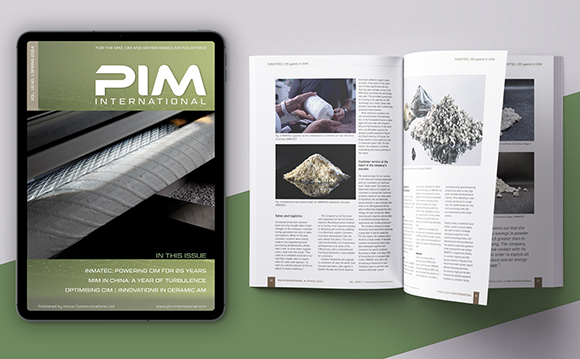PSI moves towards continuous atomisation with its largest capacity vacuum inert gas atomiser to date
August 20, 2018

Fig. 1 The new one tonne VIGA system
Phoenix Scientific Industries Ltd (PSI), Hailsham, UK, recently installed its largest capacity vacuum inert gas atomiser (VIGA) to date at a UK-based metal powder supplier. Equipped with a 500 kg capacity furnace, and having the option to add a second as production requirements increase, the system is designed to produce high-quality metal powders that are suitable for the MIM, Additive Manufacturing and HIP industries (Fig. 1). The design for the VIGA installed by PSI features two induction furnaces that are diametrically opposed and pour alternately into a central tundish, which is also heated by induction, under which sits the atomisation die (Fig. 2). PSI stated that the die is the crucial component in the system and its performance is key to the production rate of in-size powder.

Fig. 2 Schematic of the dual-furnace tilt and pour system designed for the new atomiser installed by PSI
The company stated that with this atomiser design a tonne of powder can be produced in one production cycle with evacuation and gas backfill being performed on both furnaces and melting rates being adjusted so that when one furnace is emptied, the second is available, enabling atomisation to continue without pause. “Those considering atomising system configurations might ask, ‘Why not have a single furnace of one tonne and avoid any complications that two 500 kg furnaces might confer?’” stated Bill Hopkins, Managing Director of PSI. “The answer is that big is not always better.”
Hopkins explained that, with the induction furnaces used for atomisation, the pour rate is relatively slow compared to other operations such as casting. This means large melts being held at temperature for long periods with the associated problems of refractory wear, slag and high inclusion counts – all deleterious to the quality of nickel or steel PM components used in high-performance applications.
In addition, temperature control of melt from a large induction furnace, kept at high angles of tilt for prolonged periods, is not straightforward. Faster pour rates and therefore atomisation rates of the melt, due to geometric fluid and heat flow considerations at the atomisation die, lead to higher temperatures in the near vicinity of the atomisation spray plume, with negative consequences for in-size powder yields and morphology.
Faster pour rates also imply correspondingly high atomising gas flow rates to achieve the desired median size in the as-atomised powder. The gas supply system, including pumped cryogenic supplies, is a significant capital and operating cost for a production atomiser.
Further, a tilting induction furnace occupies a significant vertical distance that must be accommodated within the diameter of the requisite cylindrical vacuum chamber, leading to disproportionate capital cost as, for a given volume, larger-diameter chambers are much more expensive than smaller diameter, longer chambers housing two smaller furnaces.

Fig. 3 IN718 nickel alloy powder produced by a PSI VIGA
Additionally, a large melt which is not poured for any reason will take much longer to cool down and restart for the next process cycle than a small one. Air melting furnaces supplying atomisation systems can readily be supplied with ‘bale out’ facilities to empty a furnace and thus save the refractory lining, but this is expensive to arrange and cumbersome to operate within a vacuum chamber.
Hopkins concluded that, in a batch process involving metal refining operations prior to the atomisation stage of the process, productivity of good quality powder is not necessarily increased by increasing furnace size. There appears to be an optimum size around the 500 kg level where the capital expenditure and operation expenditure costs, which form part of a metal powder cost, are minimised.
To optimise yields of powders for MIM, the use of atomising gas heated to 500°C to increase the yield of sub 20 µm powder to the extent that the capital investment in plant to both heat the gas and later dissipate the significant increase in thermal energy, is well-justified. Generally, a reduction of 5 µm to the d50 value of as-atomised powder is obtained compared to room temperature atomising gas.
For AM, where the desired ‘cut’ lies in the ranges 15–45 µm or 15–60 µm, atomisation parameters can be set to optimise the yield of in-size powder without the use of hot gas, and similarly for HIP. In addition, the use of lower metal pouring rates to reduce the standard deviation or ‘spread’ of the size distribution will generally increase the rate of in-size powder production and give a better product, although reducing the rate of as-atomised powder production.
Hopkins stated that, in a batch VIGA, the time spent actually atomising is a relatively small fraction of the total cycle time, which includes loading, evacuating, melting, melt conditioning (composition trimming) and cooling. As a result, to pour and atomise faster than is optimal for maximising in-size yield and quality is often counter-productive, as only a little time is saved.
However, even when batch atomisation is optimised for yield and quality, the productivity of a high-value batch VIGA is still very low in terms of capital utilisation. “In the same way that strand casting of low carbon steels displaced ingot casting in the last century, now is the time to introduce the same approach to vacuum inert gas atomisation of steels and nickel superalloys and enjoy the same capital expenditure and operating cost benefits which this approach brings to lowering powder cost,” Hopkins stated.
With air-melting furnaces, the approach is relatively simple from an engineering standpoint. Alternately pouring furnaces are arranged to feed a central tundish (Fig. 2). As long as the non-pouring furnace can be recharged and is able to produce melt faster than the alternate furnace’s contents can be atomised, then the process will continue until the pouring and feeding refractories become worn or blocked and the process is halted to replace them.
For premium quality powders, where the slag and inclusions associated with air melting are unacceptable, the challenge is to keep the atomising tundish constantly ‘topped up’ with metal which has been de-slagged, vacuum refined for oxygen and carbon control and compositionally controlled to close tolerances.
PSI reports that it is currently working with a major steel maker to interface the best and lowest cost bulk steel production techniques and deliver this molten feedstock to PSI twin-furnace atomisers for further refining actions before alternately pouring and atomising on a continuous basis. Here, the challenges are similar to those faced in the early days of continuous steel casting, e.g. control of pouring rates and development of pouring refractories to ensure the highest atomiser utilisation and lowest downtime. The company anticipates that this development will raise VIGA productivity from the 20–30% typically encountered in systems around the world, to more than 80%. This will allow a step change reduction in powder cost for MIM and AM applications and in turn promote the further growth of these industry sectors.

















